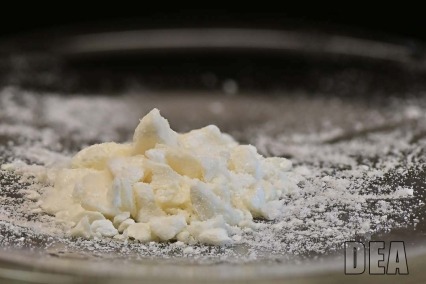Highlights

- Cocaine is an addictive stimulant drug made from the leaves of the coca plant (Erythroxylon coca) which is native to South America. Cocaine can be snorted through the nose, rubbed into gums, injected into the bloodstream, or smoked.
- Serious medical complications can occur with cocaine use, including cocaine use disorder and overdose. Also, adulteration of cocaine with highly potent fentanyl and related substances is a major contributor to the rising drug overdose deaths.
- NIDA supports and conducts research to better understand and address the health and safety effects of cocaine use.

Cocaine is an addictive stimulant drug. It is made from the leaves of the coca plant (Erythroxylon coca), which is native to South America.1
Cocaine is a Schedule II drug, which means that it has high potential for misuse but can be administered by a doctor for medical uses, such as local anesthesia for some eye, ear, and throat surgeries.
There are two chemical forms of cocaine: the water-soluble hydrochloride salt and the water-insoluble cocaine base (or freebase). Hydrochloride salt is a powder that is injected or snorted. The base form of cocaine is created by processing the drug with ammonia or sodium bicarbonate (baking soda) and water, then heating it to remove the hydrochloride to produce a smokable substance. This form of cocaine is sometimes called crack, which refers to the crackling sound of the rock as it's heated. Crack can also be used by sprinkling it on marijuana or tobacco and smoking it.
Cocaine is typically used orally, intranasally, intravenously, or by inhalation. When snorted (intranasal use), cocaine powder is inhaled through the nostrils, where it is absorbed into the bloodstream through the nasal tissues. People may also rub the drug onto their gums (oral use). Dissolving cocaine in water and injecting it (intravenous use) releases the drug directly into the bloodstream and heightens the intensity of its effects. When people smoke cocaine (inhalation), they inhale its vapor or smoke into the lungs, where absorption into the bloodstream is almost as rapid as by injection.
Cocaine use ranges from occasional to repeated or compulsive use, with a variety of patterns between these extremes. Any route of administration can potentially lead to absorption of toxic amounts of cocaine, causing heart attacks, strokes, or seizures—all of which can result in sudden death.2,3
Find cocaine images from the U.S. Drug Enforcement Administration (DEA).
Drugs like cocaine powerfully activate reward and reinforcement mechanisms in the brain. Reward refers to the euphoria or high produced when taking the drug (equivalent to “liking”); reinforcement refers to the desire to take the drug again (“wanting”).
The mechanisms of drug euphoria or reward are only somewhat understood but are now believed to involve several dispersed brain structures called “hedonic hotspots” that produce especially intense pleasure when activated simultaneously.4,5 Their activation involves several different chemical messengers including the body’s naturally occurring opioids. Reinforcement is much better understood, and it mainly involves the neurotransmitter dopamine.
The brain’s mesolimbic dopamine system, sometimes called the reward pathway, is stimulated by all types of reinforcing stimuli, such as food, sex, and many drugs, including cocaine. This pathway originates in a region of the midbrain called the ventral tegmental area and projects to other brain areas including the nucleus accumbens, where one of the brain’s hedonic hotspots is also located.6 Besides reward and reinforcement, this circuit also regulates emotions and motivation.7
In the normal communication process, dopamine is released by a neuron into the synapse (the small gap between two neurons), where it binds to specialized proteins called dopamine receptors on the neighboring neuron. By this process, dopamine acts as a chemical messenger, carrying a signal from neuron to neuron. Another specialized protein called a transporter removes dopamine from the synapse to be recycled for further use.6
Drugs can interfere with this normal communication process. For example, cocaine acts by binding to the dopamine transporter, blocking the removal of dopamine from the synapse. Dopamine then accumulates in the synapse to produce an amplified signal to the receiving neurons. This dopamine surge, simultaneous with the euphoric effects of the drug, teaches the brain that this reward is desirable and to seek it again. This reinforcement sets in motion the addiction cycle.8,9
Use of cocaine can induce long-term changes in the brain. Animal studies show that cocaine exposure can cause significant neuroadaptations in neurons that release the excitatory neurotransmitter glutamate.10,11 Animals chronically exposed to cocaine demonstrate profound changes in glutamate neurotransmission—including how much is released and the level of receptor proteins—in the reward pathway, particularly the nucleus accumbens. The glutamate system may be an opportune target for anti-addiction medication development, with the goal of reversing the cocaine-induced neuroadaptations that contribute to the drive to use the drug.10
Although researchers have focused on adaptations in the brain’s reward system, drugs also affect the brain pathways that respond to stress. Stress can contribute to cocaine recurrence, and cocaine use disorders frequently co-occur with stress-related disorders. The stress circuits of the brain are distinct from the reward pathway, but research indicates that there are important ways that they overlap. The ventral tegmental area seems to act as a critical integration site in the brain that relays information about both stress and drug cues to other areas of the brain, including ones that drive cocaine seeking. Animals that have received cocaine repeatedly are more likely to seek the drug in response to stress, and the more of the drug they have taken, the more stress affects this behavior. Research suggests that cocaine elevates stress hormones, inducing neuroadaptations that further increase sensitivity to the drug and cues associated with it.12
Chronic cocaine exposure affects many other areas of the brain too. For example, animal research indicates that cocaine perturbs the function of the orbitofrontal cortex (OFC), which appears to underlie the poor decision-making, inability to adapt to negative consequences of drug use, and lack of self-insight shown by people addicted to cocaine.13 A study using optogenetic technology, which uses light to modulate the activity of specific, genetically-modified neurons, found that stimulating the OFC restores adaptive learning in animals. This result suggests that strengthening OFC activity may be a good therapeutic approach to improve insight and awareness of the consequences of drug use among people who use cocaine.14
Cocaine’s effects appear almost immediately after a single dose and typically disappear within a few minutes to an hour. Small amounts of cocaine usually make people feel euphoric, energetic, talkative, and mentally alert.15 The drug can also temporarily decrease the need for food and sleep.16,17 Some people find that cocaine helps them perform simple physical and intellectual tasks more quickly, although others experience the opposite effect.18
The duration of cocaine’s euphoric effects depends upon the route of administration. The faster the drug is absorbed, the more intense the resulting high, but also the shorter its duration. Snorting cocaine produces a relatively slow onset of the high, but it may last from 15 to 30 minutes. In contrast, the high from smoking is more immediate but may last only 5 to 10 minutes.19
Short-term physiological effects of cocaine use include constricted blood vessels; dilated pupils; and increased body temperature, heart rate, and blood pressure.20 Large amounts of cocaine may intensify the high but can also lead to bizarre, erratic, and violent behavior. Some people who use cocaine report feelings of restlessness, irritability, anxiety, panic, and paranoia. They may also experience tremors, vertigo, and muscle twitches.2
Severe medical complications can occur with cocaine use. Some of the most frequent are cardiovascular effects, including disturbances in heart rhythm and heart attacks; neurological effects, including headaches, seizures, strokes, and coma; and gastrointestinal complications, including abdominal pain and nausea.3 In rare instances, sudden death can occur on the first use of cocaine or unexpectedly thereafter. Cocaine-related deaths are often a result of cardiac arrest or seizures.2
Many people who use cocaine also use alcohol, and this combination can be particularly dangerous. The two substances react to produce cocaethylene, which may increase the toxic effects of cocaine and alcohol on the heart.21 The combination of cocaine and opioids like heroin or fentanyl is also very dangerous. People combine these drugs because the stimulating effects of cocaine are offset by the sedating effects of an opioid; however, this can lead to taking a high dose of the opioid without initially realizing it. Because cocaine's effects wear off sooner, this can lead to an opioid overdose.22,23
With repeated exposure to cocaine, the brain starts to adapt so that the reward pathway becomes less sensitive to natural reinforcers.11,24 At the same time, circuits involved in stress become increasingly sensitive, leading to increased displeasure and negative moods when not taking the drug, which are signs of withdrawal.25 These combined effects make the affected individual more likely to focus on seeking the drug instead of relationships, food, or other natural rewards.
With regular use, tolerance may develop so that higher doses, more frequent use of cocaine, or both are needed to produce the same level of pleasure and relief from withdrawal experienced initially.11,24 At the same time, people can also develop sensitization, in which less cocaine is needed to produce anxiety, convulsions, or other toxic effects.3 Tolerance to cocaine reward and sensitization to cocaine toxicity can increase the risk of overdose.
Some people take cocaine in binges, in which cocaine is used repeatedly and at increasingly higher doses. This can lead to increased irritability, restlessness, panic attacks, paranoia, and even psychosis, in which the individual loses touch with reality and experiences auditory and visual hallucinations.2 With increasing doses or higher frequency of use, the risk of adverse psychological or physiological effects increases.2,3
Specific routes of cocaine administration can produce their own adverse effects. Regularly snorting cocaine can lead to loss of sense of smell, nosebleeds, problems with swallowing, hoarseness, and an overall irritation of the nasal septum leading to a chronically inflamed, runny nose.19 Smoking crack cocaine damages the lungs and can worsen asthma.2, People who inject cocaine have puncture marks called tracks, most commonly in their forearms,7 and they are at risk of contracting infectious diseases like HIV and hepatitis C. They also may experience allergic reactions, either to the drug itself or to additives in cocaine, which in severe cases can result in death.26
Cocaine damages many other organs in the body. It reduces blood flow in the gastrointestinal tract, which can lead to tears and ulcerations.3 Many people who use cocaine chronically lose their appetite and experience significant weight loss and malnourishment. Cocaine has significant and well-recognized toxic effects on the heart and cardiovascular system.3,27,28 Chest pain that feels like a heart attack is common and sends many people who use cocaine to the emergency room.3,28 Cocaine use is linked with increased risk of stroke,27 as well as inflammation of the heart muscle, deterioration of the ability of the heart to contract, and aortic ruptures.28
In addition to the increased risk for stroke and seizures, other neurological problems can occur with long-term cocaine use.3,24 There have been reports of intracerebral hemorrhage, or bleeding within the brain, and balloon-like bulges in the walls of cerebral blood vessels.3,24 Movement disorders, including Parkinson’s disease, may also occur after many years of cocaine use.3 Generally, studies suggest that a wide range of cognitive functions are impaired with long-term cocaine use—such as sustaining attention, impulse inhibition, memory, making decisions involving rewards or punishments, and performing motor tasks.18
Cocaine use during pregnancy is associated with migraines and seizures, premature membrane rupture, and separation of the placental lining from the uterus prior to delivery.29 Pregnancy is accompanied by normal cardiovascular changes, and cocaine use intensifies these—sometimes leading to serious problems with high blood pressure (hypertensive crises), spontaneous miscarriage, preterm labor, and difficult delivery.30 People who use cocaine and are pregnant must receive appropriate medical and psychological care—including addiction treatment—to reduce these risks.
Babies exposed to cocaine during pregnancy are often prematurely delivered, have low birth weights and smaller head circumferences, and are shorter in length than babies who are not exposed to cocaine during pregnancy.30-32
Scientists find that exposure to cocaine during fetal development may lead to subtle, yet significant, later problems in some children.33,34 These include behavior problems and learning difficulties.34,35 Some problems persist into the later years, with prenatally exposed adolescents showing increased risk for subtle problems with language and memory.36 Brain scans in teens suggests that at-rest functioning of some brain regions—including areas involved in attention, planning, and language—may differ from that of non-exposed peers.37
Currently, there are no medications approved by the U.S. Food and Drug Administration to treat cocaine use disorder. But many behavioral treatments have proven to be effective in both residential and outpatient settings. Indeed, behavioral therapies are often the only available and effective treatments for many drug problems, including stimulant use disorders.38
Contingency Management (CM)
One form of behavioral therapy that shows positive results in people with cocaine use disorders is contingency management (CM), also called motivational incentives. Programs use a voucher or prize-based system that offers patients who abstain from cocaine and other drugs with rewards. CM may be particularly useful for helping patients achieve initial abstinence from cocaine and stay in treatment.38-40 This approach has been shown to be practical and effective in community treatment programs.39
Research indicates that CM benefits diverse populations of people who use cocaine. For example, studies show that pregnant women with cocaine use disorder and women with cocaine use disorder who have young children who participated in a CM program as an adjunct to other substance use disorder treatment were able to stay abstinent longer than those who received an equivalent amount of vouchers with no behavioral requirements.41 Patients participating in CM treatment for cocaine use who also experienced psychiatric symptoms—such as depression, emotional distress, and hostility—showed a significant reduction in these problems, probably related to reductions in cocaine use.42
Cognitive-behavioral therapy (CBT)
Cognitive-behavioral therapy (CBT) is another effective approach for treating cocaine addiction. This approach helps patients develop critical skills that support long-term abstinence—including the ability to recognize the situations in which they are most likely to use cocaine, avoid these situations, and cope more effectively with a range of problems associated with drug use. This therapy can also be used in conjunction with other treatments, thereby maximizing the benefits of both.38
Researchers have developed a computerized form of CBT (CBT4CBT) that patients use in a private room of a clinic.43-45 This interactive multimedia program closely follows the key lessons and skill-development activities of in-person CBT in a series of modules. Movies present examples and information that support the development of coping skills; quizzes, games, and homework assignments reinforce the lessons and provide opportunities to practice skills.43-45 Studies have shown that adding CBT4CBT to weekly counseling boosted abstinence43 and increased treatment success rates up to 6 months after treatment.44
Therapeutic Communities (TCs)
Therapeutic communities (TCs)—drug-free residences in which people in recovery from substance use disorders help each other to understand and change their behaviors—can be an effective treatment for people who use drugs, including cocaine.46 TCs may require a 6- to 12-month stay and can include onsite vocational rehabilitation and other supportive services. TCs can also provide support in other important areas—improving legal, employment, and mental health outcomes.46,47
Aftercare
Regardless of the specific type of substance use disorder treatment, it is important that patients receive services that match all of their treatment needs. For example, an unemployed patient would benefit from vocational rehabilitation or career counseling along with addiction treatment. Patients with marital problems may need couples counseling. Once inpatient treatment ends, ongoing support—also called aftercare—can help people avoid recurrence. Research indicates that people who are committed to abstinence, engage in self-help behaviors, and believe that they have the ability to refrain from using cocaine (self-efficacy) are more likely to abstain. Aftercare serves to reinforce these traits and address problems that may increase vulnerability to recurrence, including depression and declining self-efficacy.48
Community-based recovery groups may also be helpful in maintaining abstinence.49
Latest from NIDA
Reduced drug use is a meaningful treatment outcome for people with stimulant use disorders
Men died of overdose at 2-3 times greater a rate than women in the U.S. in 2020-2021
Addiction often goes hand-in-hand with other mental illnesses. Both must be addressed.
Find More Resources on Cocaine
- Find basic information from MedlinePlus, a service of NIH’s National Library of Medicine (NLM).
- Find information for teens about cocaine from Substance Abuse and Mental Health Services Administration (SAMHSA).
- Learn more about cocaine from the Drug Enforcement Administration (DEA).
- Calatayud J, González A. History of the development and evolution of local anesthesia since the coca leaf. Anesthesiology. 2003;98(6):1503-1508. doi:10.1097/00000542-200306000-00031
- Goldstein RA, DesLauriers C, Burda AM. Cocaine: history, social implications, and toxicity--a review. Dis Mon. 2009;55(1):6-38. doi:10.1016/j.disamonth.2008.10.002
- Riezzo I, Fiore C, De Carlo D, et al. Side effects of cocaine abuse: multiorgan toxicity and pathological consequences. Curr Med Chem. 2012;19(33):5624-5646.
- Berridge KC, Dayan P. Liking. Curr Biol. 2021 Dec 20;31(24):R1555-R1557. doi: 10.1016/j.cub.2021.09.069.
- Nguyen D, Naffziger EE, Berridge KC. Positive Affect: Nature and brain bases of liking and wanting. Curr Opin Behav Sci. 2021 Jun;39:72-78. doi: 10.1016/j.cobeha.2021.02.013.
- Baik J-H. Dopamine signaling in reward-related behaviors. Front Neural Circuits. 2013;7. doi:10.3389/fncir.2013.00152.
- Sanjay Salgado, Michael G. Kaplitt; The Nucleus Accumbens: A Comprehensive Review. Stereotact Funct Neurosurg 1 March 2015; 93 (2): 75–93. https://doi.org/10.1159/000368279.
- Koob GF. Drug Addiction: Hyperkatifeia/Negative Reinforcement as a Framework for Medications Development. Pharmacol Rev. 2021 Jan;73(1):163-201. doi: 10.1124/pharmrev.120.000083.
- Koob GF, Volkow ND. Neurobiology of addiction: a neurocircuitry analysis. Lancet Psychiatry. 2016 Aug;3(8):760-773. doi: 10.1016/S2215-0366(16)00104-8.
- Schmidt HD, Pierce RC. Cocaine-induced neuroadaptations in glutamate transmission: potential therapeutic targets for craving and addiction. Ann N Y Acad Sci. 2010;1187:35-75. doi:10.1111/j.1749-6632.2009.05144.x.
- Wolf ME. The Bermuda Triangle of cocaine-induced neuroadaptations. Trends Neurosci. 2010;33(9):391-398. doi:10.1016/j.tins.2010.06.003.
- Mantsch JR, Vranjkovic O, Twining RC, Gasser PJ, McReynolds JR, Blacktop JM. Neurobiological mechanisms that contribute to stress-related cocaine use. Neuropharmacology. 2014;76, Part B:383-394. doi:10.1016/j.neuropharm.2013.07.021.
- Lucantonio F, Stalnaker TA, Shaham Y, Niv Y, Schoenbaum G. The impact of orbitofrontal dysfunction on cocaine addiction. Nat Neurosci. 2012;15(3):358-366. doi:10.1038/nn.3014.
- Lucantonio F, Takahashi YK, Hoffman AF, et al. Orbitofrontal activation restores insight lost after cocaine use. Nat Neurosci. 2014;17(8):1092-1099. doi:10.1038/nn.3763.
- Kalapatapu RK, Bedi G, Haney M, Evans SM, Rubin E, Foltin RW. The subjective effects of cocaine: relationship to years of cocaine use and current age. Am J Drug Alcohol Abuse. 2012 Nov;38(6):530-4. doi: 10.3109/00952990.2012.704461.
- Mahboub N, Rizk R, Karavetian M, de Vries N. Nutritional status and eating habits of people who use drugs and/or are undergoing treatment for recovery: a narrative review. Nutr Rev. 2021 May 12;79(6):627-635. doi: 10.1093/nutrit/nuaa095.
- Bjorness TE, Greene RW. Interaction between cocaine use and sleep behavior: A comprehensive review of cocaine's disrupting influence on sleep behavior and sleep disruptions influence on reward seeking. Pharmacol Biochem Behav. 2021 Jul;206:173194. doi: 10.1016/j.pbb.2021.173194.
- Spronk DB, van Wel JHP, Ramaekers JG, Verkes RJ. Characterizing the cognitive effects of cocaine: a comprehensive review. Neurosci Biobehav Rev. 2013;37(8):1838-1859. doi:10.1016/j.neubiorev.2013.07.003.
- Advokat C, Comaty J, Julien R. Julien’s Primer of Drug Action. 13th ed. New York, NY: Worth Publishers; 2014.
- Richards JR, Le JK. Cocaine Toxicity. In: StatPearls. StatPearls Publishing; June 8, 2024.
- Pennings EJM, Leccese AP, Wolff FA de. Effects of concurrent use of alcohol and cocaine. Addict Abingdon Engl. 2002;97(7):773-783.
- Nolan ML, Shamasunder S, Colon-Berezin C, Kunins HV, Paone D. Increased Presence of Fentanyl in Cocaine-Involved Fatal Overdoses: Implications for Prevention.J Urban Health. 2019 Feb;96(1):49-54. doi: 10.1007/s11524-018-00343-z.
- Liu X, Singer ME. Intentional use of both opioids and cocaine in the United States. Prev Med Rep. 2023 May 5;33:102227. doi: 10.1016/j.pmedr.2023.102227.
- Büttner A. Neuropathological alterations in cocaine abuse. Curr Med Chem. 2012;19(33):5597-5600.
- Volkow ND, Wang GJ, Fowler JS, Tomasi D, Telang F, Baler R. Addiction: decreased reward sensitivity and increased expectation sensitivity conspire to overwhelm the brain's control circuit. Bioessays. 2010 Sep;32(9):748-55. doi: 10.1002/bies.201000042.
- Armentia A, Martín-Armentia B, Martín-Armentia S, Ruiz-Muñoz P, Quesada JM, Postigo I, Conde R, González-Sagrado M, Pineda F, Castillo M, Palacios R, Tejedor J. Cocaine Allergy in Drug-Dependent Patients and Allergic People. J Allergy Clin Immunol Pract. 2018 Jan-Feb;6(1):201-207. doi: 10.1016/j.jaip.2017.06.013.
- Fonseca AC, Ferro JM. Drug abuse and stroke. Curr Neurol Neurosci Rep. 2013;13(2):325. doi:10.1007/s11910-012-0325-0.
- Maraj S, Figueredo VM, Lynn Morris D. Cocaine and the heart. Clin Cardiol. 2010;33(5):264-269. doi:10.1002/clc.20746.
- Bhuvaneswar CG, Chang G, Epstein LA, Stern TA. Cocaine and opioid use during pregnancy: prevalence and management. Prim Care Companion J Clin Psychiatry. 2008;10(1):59-65. doi: 10.4088/pcc.v10n0110.
- Cain MA, Bornick P, Whiteman V. The maternal, fetal, and neonatal effects of cocaine exposure in pregnancy. Clin Obstet Gynecol. 2013;56(1):124-132. doi:10.1097/GRF.0b013e31827ae167.
- Behnke M, Smith VC, Abuse C on S, Newborn C on FA. Prenatal substance abuse: short- and long-term effects on the exposed fetus. Pediatrics. 2013;131(3):e1009-e1024. doi:10.1542/peds.2012-3931.
- Gouin K, Murphy K, Shah PS, Effects of cocaine use during pregnancy on low birthweight and preterm birth: systematic review and metaanalyses. Am J Obstet Gynecol. 2011;204(4):340.e1-e12. doi:10.1016/j.ajog.2010.11.013.
- Lambert BL, Bauer CR. Developmental and behavioral consequences of prenatal cocaine exposure: a review. J Perinatol Off J Calif Perinat Assoc. 2012;32(11):819-828. doi:10.1038/jp.2012.90.
- Lester BM, Lagasse LL. Children of addicted women. J Addict Dis. 2010;29(2):259-276. doi:10.1080/10550881003684921.
- Ackerman JP, Riggins T, Black MM. A review of the effects of prenatal cocaine exposure among school-aged children. Pediatrics. 2010;125(3):554-565. doi:10.1542/peds.2009-0637.
- Buckingham-Howes S, Berger SS, Scaletti LA, Black MM. Systematic review of prenatal cocaine exposure and adolescent development. Pediatrics. 2013;131(6):e1917-e1936. doi:10.1542/peds.2012-0945.
- Li K, Zhu D, Guo L, et al. Connectomics signatures of prenatal cocaine exposure affected adolescent brains. Hum Brain Mapp. 2013;34(10):2494-2510. doi:10.1002/hbm.22082.
- Penberthy JK, Ait-Daoud N, Vaughan M, Fanning T. Review of treatment for cocaine dependence. Curr Drug Abuse Rev. 2010;3(1):49-62. doi: 10.2174/1874473711003010049.
- Petry NM, Barry D, Alessi SM, Rounsaville BJ, Carroll KM. A randomized trial adapting contingency management targets based on initial abstinence status of cocaine-dependent patients. J Consult Clin Psychol. 2012;80(2):276-285. doi:10.1037/a0026883.
- Schierenberg A, van Amsterdam J, van den Brink W, Goudriaan AE. Efficacy of contingency management for cocaine dependence treatment: a review of the evidence. Curr Drug Abuse Rev. 2012;5(4):320-331. doi: 10.2174/1874473711205040006.
- Schottenfeld RS, Moore B, Pantalon MV. Contingency management with community reinforcement approach or twelve-step facilitation drug counseling for cocaine dependent pregnant women or women with young children. Drug Alcohol Depend. 2011;118(1):48-55. doi:10.1016/j.drugalcdep.2011.02.019.
- Petry NM, Alessi SM, Rash CJ. Contingency management treatments decrease psychiatric symptoms. J Consult Clin Psychol. 2013;81(5):926-931. doi:10.1037/a0032499.
- Carroll KM, Ball SA, Martino S, et al. Computer-assisted delivery of cognitive-behavioral therapy for addiction: a randomized trial of CBT4CBT. Am J Psychiatry. 2008;165(7):881-888. doi:10.1176/appi.ajp.2008.07111835.
- Carroll KM, Ball SA, Martino S, Nich C, Babuscio TA, Rounsaville BJ. Enduring effects of a computer-assisted training program for cognitive behavioral therapy: a 6-month follow-up of CBT4CBT. Drug Alcohol Depend. 2009;100(1-2):178-181. doi:10.1016/j.drugalcdep.2008.09.015.
- Carroll KM, Kiluk BD, Nich C, et al. Computer-assisted delivery of cognitive-behavioral therapy: efficacy and durability of CBT4CBT among cocaine-dependent individuals maintained on methadone. Am J Psychiatry. 2014;171(4):436-444. doi:10.1176/appi.ajp.2013.13070987.
- Vanderplasschen W, Colpaert K, Autrique M, et al. Therapeutic communities for addictions: a review of their effectiveness from a recovery-oriented perspective. Sci World J. 2013;2013, 2013:e427817. doi:10.1155/2013/427817.
- Leon GD. Is the therapeutic community an evidence based treatment? What the evidence says. Ther Communities Int Journal Ther Support Organ. 2010;31(2):104-128.
- McKay JR, Van Horn D, Rennert L, Drapkin M, Ivey M, Koppenhaver J. Factors in sustained recovery from cocaine dependence. J Subst Abuse Treat. 2013;45(2):163-172. doi:10.1016/j.jsat.2013.02.007.
Donovan DM, Daley DC, Brigham GS, et al. Stimulant abuser groups to engage in 12-step: a multisite trial in the National Institute on Drug Abuse Clinical Trials Network. J Subst Abuse Treat. 2013;44(1):103-114. doi:10.1016/j.jsat.2012.04.004.



